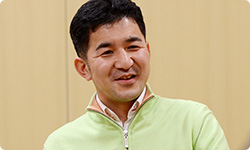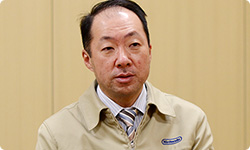2. Koji Kondo Upends the Tea Table
It’s nothing special now, but as far as I recall, no games before The Legend of Zelda: Ocarina of Time switched seamlessly to the fight music when you were on an adventure and a fight scene began.
That was new.
When a fight started, the enemy motif would start. Then, when the fight was over, it would go back to the original music. I thought the transition was really smooth and clean. The feeling of plunging into adventure was so strong that - and I’m not saying this because I was not working for Nintendo at that time but - I thought Ocarina of Time was a great masterpiece to me.
After a long history of loving Ocarina of Time, how did you come to work on the Nintendo 3DS version?
In or around March last year, they were asking if anyone was available to work on the music for it. At first, I was going to leave it to the younger guys, but Kondo-san asked me to keep an eye on them.
Kondo-san tapped you for the job?
Yeah. They were really new guys, so I wanted him to teach them all about video game music.
At first, I was involved as a supervisor.
But I bet you couldn’t bear to just look on! (laughs)
Yeah. You got that right! (laughs) I told them to run everything by me.
Because you love it. (laughs)
Earlier, we talked about how back then games could only stream sound in most cases, and we were under technological constraints this time, too, so at first we decided to stream it. It was difficult technologically to change the music in real time to fit different game situations. For that reason, at first I decided to spruce it up by arranging slightly more up-to-date music. But when I’d done about half, Kondo-san suddenly said, “Make sure you stay faithful to the Nintendo 64 sound.”

Oh. (laughs)
It was really sudden! He upended the tea table.
Is that really an upending of the tea table?
It sure was! (laughs)
Kondo-san doesn’t remember it that way. (laughs)
So I gathered together the development team and said, “We’ve got to remake all the music. We need to recreate the Nintendo 64 sound, so let’s do our best!” Then we set about redoing it all.
You decided to faithfully recreate the Nintendo 64 sound.
Yeah. By the way, Kondo-san, why did you have the music for Hyrule Field change each time?
When I first heard the plan for Ocarina of Time, I thought, “This is going to be a really big game!” There was this big field in the centre, and you needed to ride a horse to reach the other side!
Yes, Hyrule Field was big enough that you were thankful for your horse!
But if you went to all these dungeons and came back and the same old music was playing…
You’d get sick of it.
Right. I wanted to avoid players going to a dungeon and coming back to find the same song droning on. I thought about what I could do to have different music playing whenever you listened to it, and eventually I created several eight-measure “components” to play randomly.
They shared a certain chord progression, so the music could shuffle them around.
Right. Each group of eight measures ended with a chord that would lead nicely into whichever group started next. It sounded natural even when you played them randomly.
How many of those “components” did you make?
About 20. They’re in battles, too.
So even if the general atmosphere of the music is the same, it sounds different each time.
Right. In your regular RPG, when an enemy appeared, the music would suddenly switch.
The pattern for RPGs back then was for the screen to change, a fanfare to play, and fight music to start.
Yeah. But in Ocarina of Time, you can see the enemy from far off. If the music suddenly went into fight mode, you would listen to the music for the fight mode even though you hadn’t started the fighting, and when you went away, the music would switch back right away. The flow of the game would break down.
It would be hard to get into the game.
So I made eight-bar patterns for the fights, too. As you got closer to an enemy, they would smoothly transition into fighting music.

And when the fight was over, the music smoothly transitioned back.
You could compose music by thinking to that extent as early as in 1998, and I think you could do so because you had been making games together with Mr. Miyamoto.
Yeah. In the case of movies, the lengths for the safe scenes, fight scenes and calm scenes are predetermined.
Movie music is compartmentalised at the start and made in line with the pre-determined length of the video. In the case of games, players interactively move the character, and the music interactively responds.
What Kondo-san was most insistent about this time for Ocarina of Time 3D was that interactivity. He said, “You absolutely must recreate that!”
That’s right.
So even though you were arranging new music…
He overturned the tea table! (laughs)
Yep! (laughs)
But I didn’t have any intention of overturning any tea tables! I mean, if you changed the sound like that, it wouldn’t be Ocarina of Time!
Yeah…you’re right. I’m glad we fixed it!
(laughs)